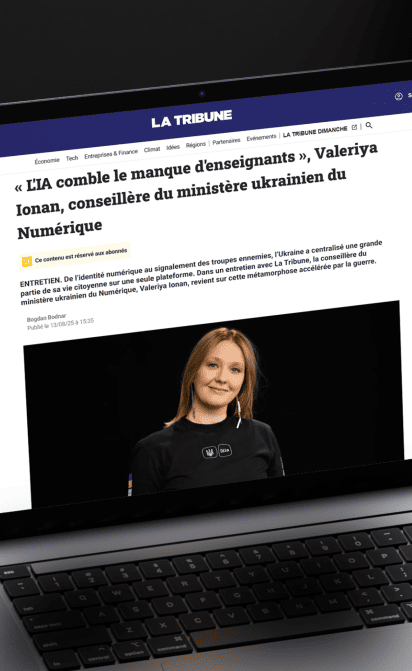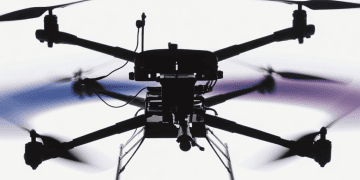- Direction:
- GovTech
Ukraine’s Digital Transformation Is Making International Headlines
- Publication date and time:
- Reading time:
- 3 min

Valeriya Ionan shares how Ukraine built a digital state — even during the full-scale russian invasion. Ukraine’s digital transformation is now being studied abroad as a model for building modern state infrastructure under extreme conditions.
In an in-depth interview with French publication La Tribune, Valeriya Ionan, Advisor to the First Deputy Prime Minister of Digital Transformation of Ukraine on Innovations, Digitalisation and Global Partnerships, outlines how Ukraine accelerated digital reforms during wartime — not just to maintain public services, but to reimagine what a state can be in the 21st century.
Ukraine’s digital strategy started in 2019 with a long-term plan to modernize public administration and shift core state functions to digital platforms. The aim was to replace outdated, paper-based bureaucracy with services that are mobile-first, transparent, and designed around citizen needs. But the full-scale russian invasion changed the pace — and the stakes. Digital reform, Ionan explains, became not just a question of modernization, but of continuity and survival.
«We started with the goal of convenience. But in wartime, digital became the only way to keep the country functioning.»
At the center of this transformation is Diia — Ukraine’s national e-governance platform. Originally launched as a digital ID and services app, Diia has since expanded into a multi-functional system that enables citizens to access over 120 public services, fully remotely. Ukrainians can file taxes, apply for benefits, manage business registrations, and submit legal documents — all via smartphone. Since the start of the war, over 8,000 couples have used Diia to register their marriage online, including soldiers doing so directly from the front lines.
Wartime conditions also prompted the integration of new, defense-oriented features. Diia now includes air raid alerts, a shelter locator, and a secure communication function called eEnemy, which allows citizens to report the movement of russian troops directly to authorities. These tools have turned the app into a national infrastructure asset — part civilian service, part defense technology.
In the interview, Ionan highlights one of Ukraine’s most urgent challenges: education. The russian war has displaced teachers, destroyed schools, and fragmented entire regional education systems. To respond, the Ministry introduced AI-powered learning solutions that are already operating at scale. More than 2,000 schools are using artificial intelligence tools in the classroom, and over 5,000 others have applied to join the program.
The solution is built on Google’s Gemini large language models, and is specifically tailored to meet local curricular standards. According to Ionan, the system was designed from day one with privacy in mind: no personal data is stored, and all student inputs are anonymized before being processed by the AI model. A state-owned Ukrainian Large Language Model is also under development, and expected to launch before the end of the year.
Ukraine’s progress has not gone unnoticed. In just five years, the country has moved from 102nd to 5th place in the UN’s global e-government development ranking. Digital tools that were initially framed as convenience features are now treated as core state functions. The Ministry is receiving increasing interest from foreign governments looking to adopt Ukrainian-developed tools in their own systems.
Digital transformation also plays a key role in Ukraine’s long-term economic strategy. Through Diia.City, a legal and tax framework for tech companies, Ukraine is creating an environment designed to attract international investment. Companies registered through Diia.City benefit from simplified compliance, special tax incentives, and access to digital infrastructure. In the defense tech sector, Ukraine has opened simulation and testing zones that allow vetted companies to trial technologies in real-world battlefield conditions — a unique capability for R&D that very few countries can offer.
For Ionan and her colleagues, the point is not just to survive the war, but to shape the country that comes after it.
«Wartime accelerated innovation. Now we’re working to convert that momentum into long-term value — for Ukraine and beyond»
The digital transformation that began as a modernization initiative is now one of Ukraine’s most visible strategic assets. It ensures government access, protects continuity of services, supports internal mobility, and reduces friction in nearly every area of public life. And now, it is increasingly being viewed as an exportable model for governments around the world.
Read the full interview in La Tribune (French).


